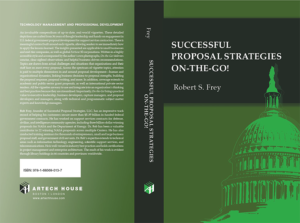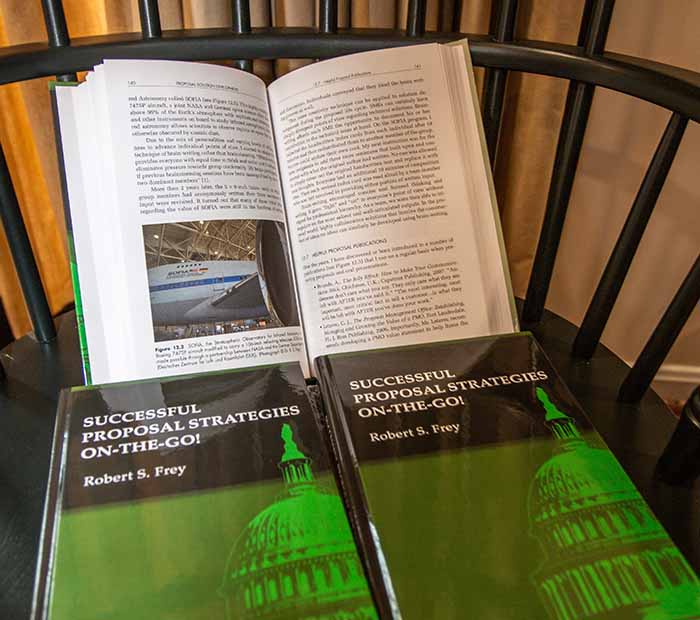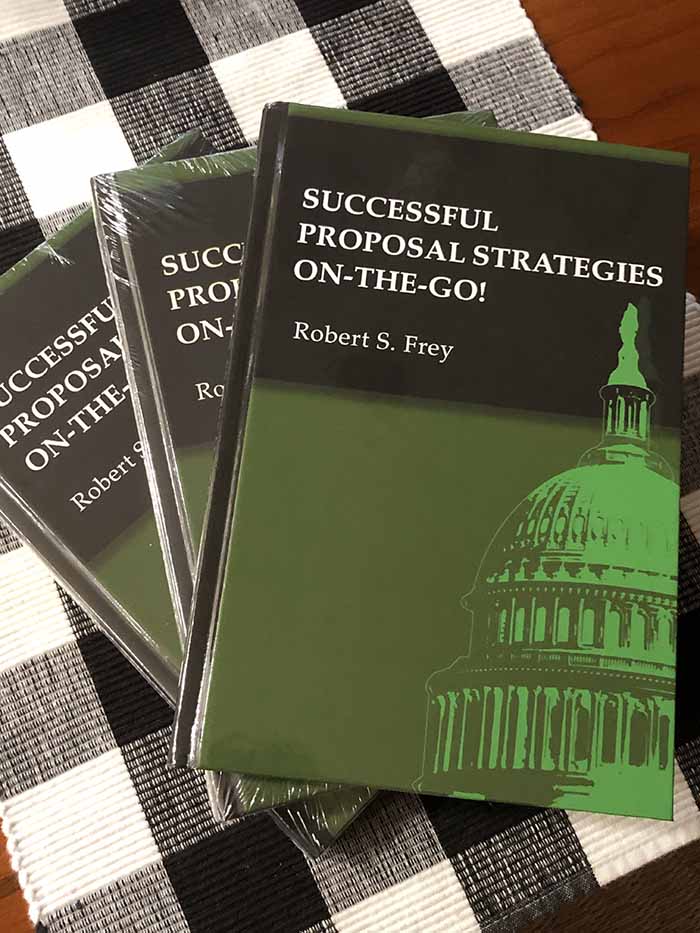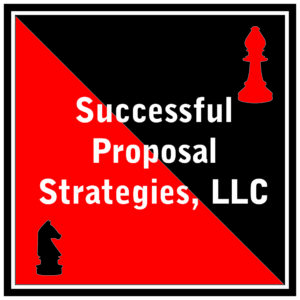Successful Proposal Strategies, LLC
Successful Proposal Strategies On-The-Go
Overview
An invaluable compendium of up-to-date, real-world vignettes, these detailed depictions are crafted from 35 years of thought leadership and hands-on engagement in U.S. Federal Government proposal development for support services contractors. There is meaningful context built around each vignette, allowing readers to see immediately how to apply the lessons learned. The insights presented are applicable to small businesses and mid-tier companies, as well as global Fortune 50 corporations. Written in a highly accessible style and accompanied by the author’s own photographs, On-the-Go! delivers concise, clear-sighted observations and helpful business-driven recommendations. Topics are drawn from actual challenges and situations that organizations and their staff professionals face every proposal. Across the spectrum of vignette topics, attention is paid to multiple dimensions in and around proposal development—human and organizational dynamics, linking business decisions to proposal strengths, building the proposal response, proposal writing, and more. In addition, coverage extends to academic and public-sector grant proposals, as well as international private-sector tenders. All the vignettes are easy to use and integrate into an organization’s thinking and best practices because they are streamlined. Importantly, On-the-Go! brings practical value to executive leadership, business developers, capture managers, and proposal developers and managers, along with technical and programmatic subject matter experts and knowledge managers.

Table of Contents
Chapter 1: Focused Passion
1.1 Leadership Across Time and Geography
1.2 Power of Proposal Win Bonuses
1.3 Proposals and Proposaling in Context
1.4 Focused Passion Helps Win Federal Proposals
1.5 First Things First
1.6 Inspiring Passion
Chapter 2: Proposaling in Context: Where Does the Proposal Fit within the Entire Marketing Lifecycle?
2.1 Introduction
2.2 Wrapping Business Development, Capture Management, and Proposal Development in a Blanket
2.3 Everyone in Your Company Is in Business Development
2.4 Looking Through the Lens of PMBOK
2.5 Using the Lens of PMBOK to Focus on Capture Management
2.6 Proposal Development—Pathway to Successful Blue Team Review
2.7 Knowledge Management through the Lens of PMBOK
Chapter 3: The Importance of Human Dynamics
3.1 Metaphors Matter
3.2 The 71% Effect
3.3 Stop Drowning in Meetings
3.4 Searching for Effective Communication
3.5 Organizational Culture and Performance Success
3.6 References for Building Effective Teams
Chapter 4: Proposal Development and Knowledge Management
4.1 Collaboration Tools
4.2 Spinning Proposal Gold
4.3 Agile Project Management and Effective Knowledge Sharing in Organizations
4.4 Lighting the Way—Getting the Most Out of What You Know
4.5 Artificial Intelligence (AI) and Knowledge Management (KM) in Proposal Land
Chapter 5: Stated and Unstated Criteria
5.1 Stated and Unstated Criteria
5.2 Deeper Insight into Unstated Evaluation Criteria
5.3 Key Questions to Ask Government Civil Servants to Learn About Unstated Criteria
5.4 Getting Credit for Your Strengths—Shaping the Final RFP
5.5 Candidate Instructions to Offerors Language (Section L)
5.6 Candidate Evaluation Factors Language (Section M)
5.7 Candidate Section L Language
5.8 Candidate Evaluation Factor Language
5.9 Candidate Section L Language
5.10 Candidate Evaluation Factor Language
5.11 Forty-five Strengths Is the New Target
Chapter 6: Moving Beyond Compliance
6.1 Proposal Compliance is Necessary but not Sufficient
6.2 Font and Line Spacing—Still Critical Aspects of Proposaling
6.3 Straightforward Compliance Can Be Challenging
6.4 Building a Meaningful Compliance Matrix
Chapter 7: Look-and-Feel of a Winning Proposal
7.1 What’s a Winning Proposal Look Like?
7.2 Good Is the Enemy of Great
7.3 The Most Important Factors in Winning
7.4 Staying Sharp—Business Acquisition as a Formal Process
Chapter 8: Hopscotching Through Proposal-Land
8.1 Proposal Integration Map
8.2 Framing and Proposal Development
8.3 Making Your Business Processes Stand Out
8.4 Communication as a Critical Success Factor in Proposal Development
8.5 Federal Proposal Development—Comprehensive Risk Management Approach
8.6 Federal Government Proposals—“Responsible” Contractor
8.7 Take Contractor Responsibility Determinations (CRDs) Seriously
8.8 Oral Presentations
8.8.1 Best Practices for Virtual Oral Presentations
8.8.2 Selecting the Optimal Oral Presenters
8.9 Inquiring Minds
Chapter 9: The Importance of “Understanding”: Sections L and M
9.1 Paint a Picture of Genuine “Understanding” in Your Proposals
9.2 Missing the Point of “Understanding”
Chapter 10: Orchestrating Team Interaction and Developing an On-Target Proposal Approach
10.1 Proposal Directive—Living “Encyclopedia” of a Win
10.2 The Critical Role of the Proposal Manager
10.3 “Pulling Intriguing Threads”—Interviews with Technical Subject Matter Experts
10.4 Rules of Engagement for Effective Proposal Meetings
10.5 Building Your Technical Approach Sections for a U.S. Government Proposal
10.6 Increasing Effectiveness in Remote Proposal Development Environments
Chapter 11: Using Section M as a “Window”
11.1 Federal Proposal Development—Looking Through the “Window” of Section M
Chapter 12: Proposal Solution Development
12.1 Solution Development Overview
12.2 Solution Development Tools
12.3 Solution Development Process
12.4 Framework for Technical Solution Development
12.5 “Box-in-a-Box Model” for Proposal Development
12.6 Solution Development—Effective Alternative to Brainstorming
12.7 Helpful Proposal Publications
Chapter 13: Precursor to the Executive Summary
13.1 Precursor to the Executive Summary
13.2 Win Strategy White Paper as a Solution Development Tool
13.3 The Executive Summary as a Requirement
Chapter 14: Multiple Palettes
14.1 Another Palette—Meaningful Proposal Cover Letter
14.2 Proposal Graphics and Proposal Cover Design
14.3 Websites—Proposal Support Platform, and Source for Protest
14.4 Proposal Protest Source Materials
14.5 LinkedIn Profiles of Key Personnel
Chapter 15: Proposal Writing
15.1 Proposals Are Knowledge-Based Sales Documents
15.2 ABCs of Proposal Writing
15.3 Writing Standards
15.4 Abstracting as a Proposal Skill
15.5 Active Voice Adds Strength and Saves Space
15.6 Action Captions
15.7 Methods of Enhancing Your Proposal Writing and Editing
15.8 Resources to Support Your Company’s Proposal Writing Efforts
15.9 Potpourri
15.10 Take Off in the Right Direction: Defining Acronyms Early in Your Proposal Development Process
15.11 Dovetailing—Fit Your Proposal Exactingly with the Federal RFP
15.12 Words to Avoid in Your Proposals
Chapter 16: Linking Key Business Decisions to Proposal Strengths
16.1 Source Selection Documents and Proposal Strengths
16.2 Linking Key Business Decisions to Proposal Strengths
16.3 Pointing the Way—Answers to Training Participants’ Questions
16.4 Post-Award Debriefings
16.5 Leveraging Source Selection Statements to Make Key Business Decisions
Chapter 17: Looking at Proposal Reviews from Different Angles
17.1 Vertical and Horizontal Proposal Reviews
17.2 Measure What’s Important—Ensuring Strengths for Your Company Appear in the Government’s Source Selection Statement
17.3 Combining Agile Scrum and SAM
17.4 Agile in Context
17.5 References
Chapter 18: Building the Cost/Price Volume
18.1 Overview of the FAR
18.2 Defining Key Pricing Terminology
18.2.1 Cost Objective
18.2.2 Final Cost Objective
18.2.3 Direct Costs
18.2.4 Direct Labor (DL)
18.2.5 Subcontractor Labor
18.2.6 Labor Categories
18.2.7 Other Direct Costs (ODCs)
18.2.8 Indirect Costs
18.2.9 Fringe Benefits (Fringe)
18.2.10 Overhead (OH)
18.2.11 Procurement
18.2.12 General and Administrative (G&A)
18.2.13 Fully Burdened Rate (FBR)
18.2.14 Fee
18.2.15 Unallowable Costs
18.3 Overview of Federal Travel Regulations (FTR)
18.4 Overview of the Cost Accounting Standards (CAS)
18.5 Overview of Relevant Generally Accepted Accounting Principles (GAAP)
18.6 Adequacy of Contractor’s Internal Accounting System
18.7 The Defense Contract Audit Agency (DCAA)
18.8 RFP Review
18.9 Importance of Aligning the Cost Proposal with the Technical and Management Proposals
18.10 Cost Estimating Methods
18.11 Methodology for Determining Salary Ranges
18.12 Methodology for Computing Labor Escalation
18.13 Highlights of the Process to Calculate Indirect Costs
18.14 Determining Annual Productive Labor Hours
18.15 Methodology to Compute Fee
18.16 Cost Volume Narrative and Production
18.17 Audit Files
18.18 Special Topics
18.18.1 Uncompensated Overtime
18.18.2 Addressing Risk in the Cost Volume
18.18.3 What is Cost Realism?
18.18.4 What is Cost Reasonableness?
18.18.5 What is Cost or Pricing Data?
18.18.6 Price to Win (PTW)
18.18.7 Common Cost Proposal Problems
18.18.8 Useful Websites and Templates
18.19 Price Proposal Reference
Chapter 19: Academic and Government Grant Proposals/International and Private-Sector Proposals
19.1 Federal Grants
19.2 Federal Contracts
19.3 Comparison of Grant Proposal Writing and Competitive Federal Proposal Writing
19.4 International Commercial Proposal Development
Chapter 20—Epilogue
20.1 Direct Benefits of Federal Subcontracting Goals, Strategic Partnering, and Mentor-Protégé Relationships
20.2 Specific Strategies for Achieving Federal and Private-Sector Subcontracts
20.3 Best-Practice B&P Scenario—Shift Left
20.4 So, You’re Just Getting Started with Proposals


